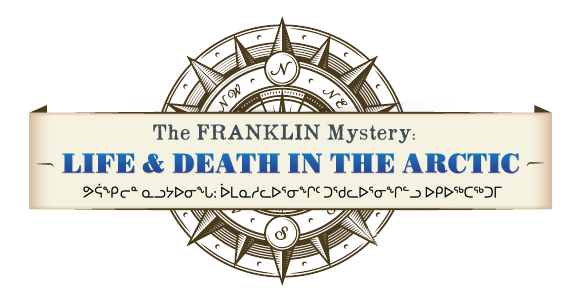Biggest search party yet for Franklin's lost ships (2014)
They were stuck in the ice deep in the Canadian Arctic, starving and without hope of rescue when the surviving crew of Sir John Franklin’s expedition abandoned ship and set out on foot across the frozen barren lands.
That was the last time anyone laid eyes on the Erebus and Terror, two iron-plated Royal Navy ships on a mission to discover the Northwest Passage. It was April 1848.
In the 166 years since, clues have turned up across the tundra: hastily scribbled notes left in cairns, silver spoons in Inuit villages, even frozen crew members exhumed from their icy graves. But no one has ever found the ships, whose fate has become one of the most enduring mysteries of the Canadian frontier.
[…]
This August, an armada of Canadian Arctic vessels equipped with cutting-edge technology is sailing to the last reported location of Franklin’s ships in the most concerted effort yet to find them.
The Wilfrid Laurier, an 83-metre coast guard icebreaker, and HMCS Kingston, a 55-metre navy patrol ship, will be joined by the Martin Bergmann, a 19-metre research vessel operated by the Arctic Research Foundation, and the 117-metre One Ocean Voyager, a private cruise ship to house additional equipment.
The flotilla will be supported by zodiacs, unmanned submarines, a helicopter and state-of-the-art multi-beam and side-scan sonar, deployed together in a carefully choreographed survey of the ocean floor.
Parks Canada is co-ordinating the effort along with the Royal Canadian Geographical Society [RCGS] and they've got some high-power and high-profile private sector sponsors including Research In Motion founder Jim Balsillie — who will be personally accompanying the search party.
…
No one knows how far the ice carried the ships before they sunk, or whether they were crushed in the process, but the research team has taken their last known location and studied ice floe patterns in order to calculate their likely route.
"If you lose your keys, you always want to go back to the last place you saw them," said Geiger [CEO of the RCGS]. "For Franklin, that place is the Victoria Strait. That’s where you want to look."
The High Arctic remains one of the world’s most remote and inhospitable environments, locked in ice year round save for a few weeks in August.
The Victoria Strait, where the ships are believed to be, is one of the last places to open up and the first to freeze back over, turning one of the country’s longest-running searches into a late summer sprint. Once in position, the flotilla will have to work around the clock until the ice begins to close up again. While simple access is the first barrier, once there, the search party still has a legion of obstacles to surmount.
[…]
Deep Arctic water requires powerful sonar to reach the bottom, while silt makes the job even more difficult by hampering the signal. The navy will be using a new autonomous underwater vehicle (AUV) built in British Columbia that will dive deep beneath the ships and employ a high-resolution synthetic aperture sonar made in Newfoundland and an acoustic homing-system manufactured in Nova Scotia.
The sonars will be run in straight lines back and forth through the search area — a pattern Newton says is "like mowing a lawn." The information collected by the AUV is collected by computers on-board the ships and plotted into a full-colour map of the ocean floor capable of detecting small objects and able to distinguish between a rock and a boiler.
[…]
The expedition organizers take hope from the recent discovery of an incredibly well preserved ship in similar waters. In 2010, a Parks Canada expedition discovered HMS Investigator, one of the rescue ships sent to search for Franklin and his men and later abandoned in the ice off Banks Island.
The ship’s copper-plated hull was intact, while leather shoes and muskets were preserved by silt buildup on deck. Unlike shipwrecks in the Caribbean, where barnacles quickly grow and sea life moves in, the cold water of the Arctic provides a perfect preserving agent, leaving things in remarkable states, even after more than a century on the bottom.
[…]
The short open-water season has forced previous searches to be shots in the dark. But climate change has been opening up the area for longer stretches in recent years, allowing for a more systematic approach.
The federal government started by sending out a single ship in 2008 and has sent out similar search expeditions each year since. These searches have produced detailed charts of over 1,200 square kilometres of seabed, definitively ruling out large areas where Franklin’s ships won’t be found. But this year’s expedition, with its beefed-up force and experimental technology, will cover more ground than all previous expeditions combined.
[…]
Now, the dream of a navigable Arctic shipping route is quickly becoming reality. In the past, adventure seekers in yachts would pull up at the edge of the ice and hope that a brief opening would allow them through. Now, a wide channel opens reliably each year for up to six weeks. Last fall, the Nordic Orion, a 225-metre cargo ship hauled 15,000 tons of coal from Vancouver to Finland, becoming the first commercial carrier to pass through the Northwest Passage.
This increased traffic also raises issues of security — a challenge the Harper government has made a priority by ordering eight state-of-the-art Arctic patrol ships. While the navy waits for the new ships to be built, it has stepped up its Arctic patrols and become an enthusiastic supporter of the search for the Erebus and Terror, which in turn provides training for crew members and detailed maps.
In this way, the search for the ships is actually becoming a way to complete Franklin’s mission of charting a commercial route through the northern sea — more than 160 years after he started.


